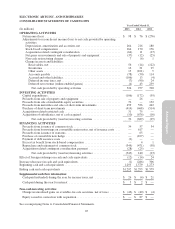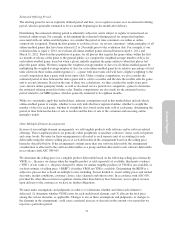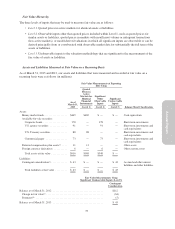Electronic Arts 2013 Annual Report Download - page 153
Download and view the complete annual report
Please find page 153 of the 2013 Electronic Arts annual report below. You can navigate through the pages in the report by either clicking on the pages listed below, or by using the keyword search tool below to find specific information within the annual report.
Annual Report
not that the fair value of a reporting unit exceeds its carrying amount, we do not need to perform the two-step
impairment test. If based on that assessment, we believe it is more likely than not that the fair value of the
reporting unit is less than its carrying value, a two-step goodwill impairment test will be performed. The first step
measures for impairment by applying fair value-based tests at the reporting unit level. The second step (if
necessary) measures the amount of impairment by applying fair value-based tests to the individual assets and
liabilities within each reporting unit. Reporting units are determined by the components of operating segments
that constitute a business for which (1) discrete financial information is available and (2) segment management
regularly reviews the operating results of that component. We determined that it was more likely than not that the
fair value of our reporting unit exceeded its carrying amount and, as such, we did not need to perform the two-
step impairment test.
During the fiscal years ended March 31, 2013, 2012 and 2011, we completed our annual goodwill impairment
testing in the fourth quarter of each year and did not recognize any impairment charges on goodwill in fiscal
years 2013, 2012, and 2011.
Taxes Collected from Customers and Remitted to Governmental Authorities
Taxes assessed by a government authority that are both imposed on and concurrent with specific revenue
transactions between us and our customers are presented on a net basis in our Consolidated Statements of
Operations.
Concentration of Credit Risk, Significant Customers and Platform Partners
We extend credit to various companies in the retail and mass merchandising industries. Collection of trade
receivables may be affected by changes in economic or other industry conditions and may, accordingly, impact
our overall credit risk. Although we generally do not require collateral, we perform ongoing credit evaluations of
our customers and maintain reserves for potential credit losses. Invoices are aged based on contractual terms with
our customers. The provision for doubtful accounts is recorded as a charge to general and administrative expense
when a potential loss is identified. Losses are written off against the allowance when the receivable is determined
to be uncollectible. Worldwide, we had two customers who accounted for approximately 23 percent and one
customer who accounted for 17 percent of our consolidated gross receivables as of March 31, 2013 and 2012,
respectively. We did not have any additional customers that exceeded 10 percent of our consolidated gross
receivables as of March 31, 2013 and 2012.
A majority of our sales are made to major retailers and distributors. During the fiscal year ended March 31, 2013,
approximately 61 percent of our North America sales were made to our top ten customers. Though our products
are available to consumers through a variety of retailers and directly through us, the concentration of our sales in
one, or a few, large customers could lead to a short-term disruption in our sales if one or more of these customers
significantly reduced their purchases or ceased to carry our products.
Currently, a majority of our revenue is derived through sales on two hardware consoles. 60 percent, 61 percent
and 57 percent of our sales were for products and services on Sony’s PLAYSTATION 3 and Microsoft’s Xbox
360 consoles combined, for the fiscal years ended March 31, 2013, 2012 and 2011, respectively. These platform
partners have significant influence over the products and services that we offer on their platform. Our agreements
with Sony and Microsoft typically give significant control to them over the approval, manufacturing and
distribution of our products and services, which could, in certain circumstances, leave us unable to get our
products and services approved, manufactured and provided to customers.
Short-term investments are placed with high quality financial institutions or in short-duration, investment-grade
securities. We limit the amount of credit exposure in any one financial institution or type of investment
instrument.
Revenue Recognition
We evaluate revenue recognition based on the criteria set forth in Financial Accounting Standards Board
(“FASB”) Accounting Standards Codification (“ASC”) 605, Revenue Recognition and ASC 985-605, Software:
Revenue Recognition. We classify our revenue as either product revenue or service and other revenue.
69
























